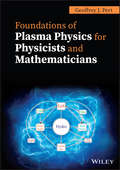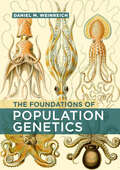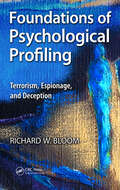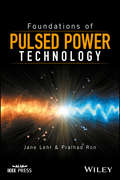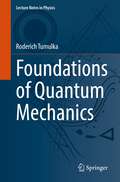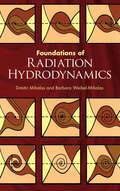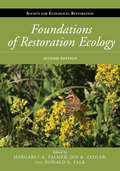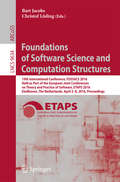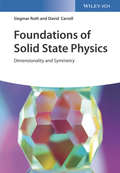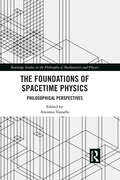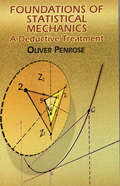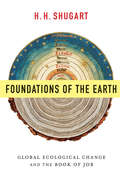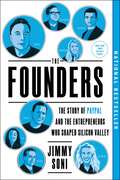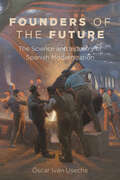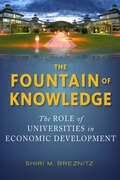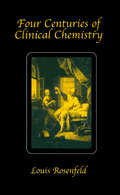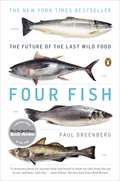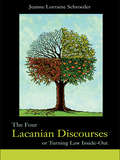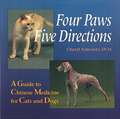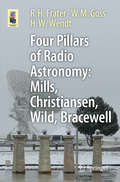- Table View
- List View
Foundations of Plasma Physics for Physicists and Mathematicians
by G. J. PertA comprehensive textbook on the foundational principles of plasmas, including material on advanced topics and related disciplines such as optics, fluid dynamics, and astrophysics Foundations of Plasma Physics for Physicists and Mathematicians covers the basic physics underlying plasmas and describes the methodology and techniques used in both plasma research and other disciplines such as optics and fluid mechanics. Designed to help readers develop physical understanding and mathematical competence in the subject, this rigorous textbook discusses the underlying theoretical foundations of plasma physics as well as a range of specific problems, focused on those principally associated with fusion. Reflective of the development of plasma physics, the text first introduces readers to the collective and collisional behaviors of plasma, the single particle model, wave propagation, the kinetic effects of gases and plasma, and other foundational concepts and principles. Subsequent chapters cover topics including the hydrodynamic limit of plasma, ideal magneto-hydrodynamics, waves in MHD plasmas, magnetically confined plasma, and waves in magnetized hot and cold plasma. Written by an acknowledged expert with more than five decades’ active research experience in the field, this authoritative text: Identifies and emphasizes the similarities and differences between plasmas and fluids Describes the different types of interparticle forces that influence the collective behavior of plasma Demonstrates and stresses the importance of coherent and collective effects in plasma Contains an introduction to interactions between laser beams and plasma Includes supplementary sections on the basic models of low temperature plasma and the theory of complex variables and Laplace transforms Foundations of Plasma Physics for Physicists and Mathematicians is the ideal textbook for advanced undergraduate and graduate students in plasma physics, and a valuable compendium for physicists working in plasma physics and fluid mechanics.
The Foundations of Population Genetics
by Daniel M. WeinreichAn accessible but rigorous treatment of the theoretical foundations of population genetics.Population genetics—the branch of evolutionary biology concerned with understanding how and why populations&’ genetic compositions change over time—rests on a well-developed theoretical foundation that draws on genetics, mathematics, and computer science. This textbook provides an approachable but rigorous treatment for advanced undergraduate and graduate students interested in building a quantitative understanding of the genetics of evolution. Existing texts either assume very mathematically advanced readers, or avoid much of the underlying theory, instead focusing on current methods of data analysis. In contrast, The Foundations of Population Genetics develops the theory from first principles. Requiring only confidence in algebra, this self-contained, student-friendly book illustrates the conceptual framework, terminology, and methods of mathematical modeling. It progressively introduces concepts from genetics as needed, while emphasizing biological implications throughout. As a result, readers come away with a deep understanding of the structure of population genetics without needing to master its mathematics.Connects theory with the most recent genetic data better than existing textsFeatures engaging real-world examples and extensive original figuresProvides dozens of carefully scaffolded questions that deepen the reader's understanding of key conceptsIdeal as a succinct reference for established scientists in biology, medicine, and computer scienceInstructor resources available
Foundations of Psychological Profiling: Terrorism, Espionage, and Deception
by Richard BloomProfiling is a hot topic today. The post-9/11 "War on Terrorism" has engendered political, ethical, and scientific controversy over its use. The proliferation of recent films, television programs, and books is a sociocultural indicator of widespread interest. Designed for a diverse audience including law enforcement officers, intelligence and secur
Foundations of Pulsed Power Technology
by Pralhad Ron Jane LehrExamines the foundation of pulse power technology in detail to optimize the technology in modern engineering settings Pulsed power technologies could be an answer to many cutting-edge applications. The challenge is in how to develop this high-power/high-energy technology to fit current market demands of low-energy consuming applications. This book provides a comprehensive look at pulsed power technology and shows how it can be improved upon for the world of today and tomorrow. Foundations of Pulsed Power Technology focuses on the design and construction of the building blocks as well as their optimum assembly for synergetic high performance of the overall pulsed power system. Filled with numerous design examples throughout, the book offers chapter coverage on various subjects such as: Marx generators and Marx-like circuits; pulse transformers; pulse-forming lines; closing switches; opening switches; multi-gigawatt to multi-terawatt systems; energy storage in capacitor banks; electrical breakdown in gases; electrical breakdown in solids, liquids and vacuum; pulsed voltage and current measurements; electromagnetic interference and noise suppression; and EM topology for interference control. In addition, the book: Acts as a reference for practicing engineers as well as a teaching text Features relevant design equations derived from the fundamental concepts in a single reference Contains lucid presentations of the mechanisms of electrical breakdown in gaseous, liquid, solid and vacuum dielectrics Provides extensive illustrations and references Foundations of Pulsed Power Technology will be an invaluable companion for professionals working in the fields of relativistic electron beams, intense bursts of light and heavy ions, flash X-ray systems, pulsed high magnetic fields, ultra-wide band electromagnetics, nuclear electromagnetic pulse simulation, high density fusion plasma, and high energy- rate metal forming techniques.
Foundations of Quantum Gravity
by James LindesayExploring how the subtleties of quantum coherence can be consistently incorporated into Einstein's theory of gravitation, this book is ideal for researchers interested in the foundations of relativity and quantum physics. The book examines those properties of coherent gravitating systems that are most closely connected to experimental observations. Examples of consistent co-gravitating quantum systems whose overall effects upon the geometry are independent of the coherence state of each constituent are provided, and the properties of the trapping regions of non-singular black objects, black holes, and a dynamic de Sitter cosmology are discussed analytically, numerically, and diagrammatically. The extensive use of diagrams to summarise the results of the mathematics enables readers to bypass the need for a detailed understanding of the steps involved. Assuming some knowledge of quantum physics and relativity, the book provides textboxes featuring supplementary information for readers particularly interested in the philosophy and foundations of the physics.
Foundations of Quantum Mechanics (Lecture Notes in Physics #1003)
by Roderich TumulkaThis book introduces and critically appraises the main proposals for how to understand quantum mechanics, namely the Copenhagen interpretation, spontaneous collapse, Bohmian mechanics, many-worlds, and others. The author makes clear what are the crucial problems, such as the measurement problem, related to the foundations of quantum mechanics and explains the key arguments like the Einstein-Podolsky-Rosen argument and Bell’s proof of nonlocality. He discusses and clarifies numerous topics that have puzzled the founding fathers of quantum mechanics and present-day students alike, such as the possibility of hidden variables, the collapse of the wave function, time-of-arrival measurements, explanations of the symmetrization postulate for identical particles, or the nature of spin. Several chapters are devoted to extending the different approaches to relativistic space-time and quantum field theory. The book is self-contained and is intended for graduate students and researchers who want to step into the fundamental aspects of quantum physics. Given its clarity, it is accessible also to advanced undergraduates and contains many exercises and examples to master the subject.
Foundations of Radiation Hydrodynamics
by Barbara Weibel Mihalas Dimitri MihalasRadiation hydrodynamics is a broad subject that cuts across many disciplines in physics and astronomy: fluid dynamics, thermodynamics, statistical mechanics, kinetic theory, and radiative transfer, among others. The theory developed in this book by two specialists in the field can be applied to the study of such diverse astrophysical phenomena as stellar winds, supernova explosions, and the initial phases of cosmic expansion, as well as the physics of laser fusion and reentry vehicles. As such, it provides students with the basic tools for research on radiating flows.Largely self-contained, the volume is divided into three parts: Chapters 1 to 5 focus on the dynamics of nonradiating fluids and then consider applications of a few astrophysically interesting problems concerning waves, shocks, and stellar winds. The second part of the book -- Chapters 5 to 8 -- deals with the physics of radiation, radiation transport, and the dynamics of radiating fluids, emphasizing the close relationship of radiation hydrodynamics to ordinary fluid dynamics. Part 3 comprises a short appendix on tensor calculus, explaining the use of tensor concepts in writing equations that allow a simple transition from ordinary fluids to relativistic fluids to radiation.Combining relevant material scattered widely among a large number of books, journal papers, and technical reports, this volume will be of immense value to students and researchers in many fields. 1984 edition.
Foundations of Restoration Ecology (The Science and Practice of Ecological Restoration Series)
by Donald A. Falk Joy B. Zedler Karen Holl Margaret A. PalmerThe practice of ecological restoration, firmly grounded in the science of restoration ecology, provides governments, organizations, and landowners a means to halt degradation and restore function and resilience to ecosystems stressed by climate change and other pressures on the natural world. Foundational theory is a critical component of the underlying science, providing valuable insights into restoring ecological systems effectively and understanding why some efforts to restore systems can fail. In turn, on-the-ground restoration projects can help to guide and refine theory, advancing the field and providing new ideas and innovations for practical application.This new edition of Foundations of Restoration Ecology provides the latest emerging theories and ideas in the science of restoration ecology. Fully one-third longer than the first edition and comprehensive in scope, it has been dramatically updated to reflect new research. Included are new sections devoted to concepts critical to all restoration projects as well as restoration of specific ecosystem processes, including hydrology, nutrient dynamics, and carbon. Also new to this edition are case studies that describe real-life restoration scenarios in North and South America, Europe, and Australia. They highlight supporting theory for restoration application and other details important for assessing the degree of success of restoration projects in a variety of contexts. Lists at the end of each chapter summarize new theory introduced in that chapter and its practical application.Written by acclaimed researchers in the field, this book provides practitioners as well as graduate and undergraduate students with a solid grounding in the newest advances in ecological science and theory.
Foundations of Signal Processing
by M. Vetterli J. Kova Evi V. K. GoyalThis comprehensive and engaging textbook introduces the basic principles and techniques of signal processing, from the fundamental ideas of signals and systems theory to real-world applications. Students are introduced to the powerful foundations of modern signal processing, including the basic geometry of Hilbert space, the mathematics of Fourier transforms, and essentials of sampling, interpolation, approximation and compression The authors discuss real-world issues and hurdles to using these tools, and ways of adapting them to overcome problems of finiteness and localization, the limitations of uncertainty, and computational costs. It includes over 160 homework problems and over 220 worked examples, specifically designed to test and expand students' understanding of the fundamentals of signal processing, and is accompanied by extensive online materials designed to aid learning, including Mathematica® resources and interactive demonstrations.
Foundations of Software Science and Computation Structures
by Christof Löding Bart JacobsThis book constitutes the proceedings of the 19thInternational Conference on Foundations of Software Science and ComputationStructures, FOSSACS 2016, which took place in Eindhoven, The Netherlands, inApril 2016, held as Part of the European Joint Conferences on Theory andPractice of Software, ETAPS 2016. The 31 full papers presented in this volume werecarefully reviewed and selected from 85 submissions. They were organized intopical sections named: types; recursion and fixed-points; verification andprogram analysis; automata, logic, games; probabilistic and timed systems;proof theory and lambda calculus; algorithms for infinite systems; and monads.
Foundations of Solid State Physics: Dimensionality and Symmetry
by Siegmar Roth David CarrollAn essential guide to solid state physics through the lens of dimensionality and symmetry Foundations of Solid State Physics introduces the essential topics of solid state physics as taught globally with a focus on understanding the properties of solids from the viewpoint of dimensionality and symmetry. Written in a conversational manner and designed to be accessible, the book contains a minimal amount of mathematics. The authors?noted experts on the topic?offer an insightful review of the basic topics, such as the static and dynamic lattice in real space, the reciprocal lattice, electrons in solids, and transport in materials and devices. The book also includes more advanced topics: the quasi-particle concept (phonons, solitons, polarons, excitons), strong electron-electron correlation, light-matter interactions, and spin systems. The authors' approach makes it possible to gain a clear understanding of conducting polymers, carbon nanotubes, nanowires, two-dimensional chalcogenides, perovskites and organic crystals in terms of their expressed dimension, topological connectedness, and quantum confinement. This important guide: -Offers an understanding of a variety of technology-relevant solid-state materials in terms of their dimension, topology and quantum confinement -Contains end-of-chapter problems with different degrees of difficulty to enhance understanding -Treats all classical topics of solid state physics courses - plus the physics of low-dimensional systems Written for students in physics, material sciences, and chemistry, lecturers, and other academics, Foundations of Solid State Physics explores the basic and advanced topics of solid state physics with a unique focus on dimensionality and symmetry.
The Foundations of Spacetime Physics: Philosophical Perspectives (Routledge Studies in the Philosophy of Mathematics and Physics)
by Antonio VassalloThis book provides an up-to-date overview of the foundations of spacetime physics. It features original essays written by world-class experts in the physics and philosophy of spacetime. The foundational questions regarding the origin and nature of spacetime are branching into new and exciting directions. These questions are not restricted to the quantum gravity program but also arise in the context of a well-established theory like general relativity. Against the background of these quick and diverse developments, this volume features a broad range of perspectives on spacetime. Part I focuses on the nature of spacetime in non-quantum theories, such as Newtonian mechanics and relativity. Part II explores some intriguing conceptual implications of developing a quantum theory of spacetime. The Foundations of Spacetime Physics is an essential resource for scholars and advanced students working in philosophy of physics, philosophy of science, and scientific metaphysics.
Foundations of Statistical Mechanics: A Deductive Treatment
by Oliver PenroseThis volume demonstrates the manner in which statistical mechanics can be built up deductively from a small number of well-defined physical assumptions. A solid basis for the deductive structure is provided by embodying these assumptions in a system of five postulates that describe an idealized model of real physical systems. These postulates play a theoretical role similar to that of the first and second laws in thermodynamics.The first chapter concerns the primary physical assumptions and their idealization in the form of postulates. The following three chapters examine the consequences of these postulates, culminating in the derivation of the fundamental formulas for calculating probabilities in terms of dynamical quantities. Two concluding chapters are devoted to an analysis of the notion of entropy, illustrating its links between statistical mechanics and thermodynamics and between statistical mechanics and communication theory. Because this book deals mostly with general principles, its only detailed considerations of physical applications are in terms of the system with the simplest possible dynamics: the ideal classical gas, which is discussed both in its equilibrium and its nonequilibrium aspects.Intended for readers with a knowledge of physics at the advanced undergraduate and graduate levels, this volume considers topics of interest not only to physicists, but also to statisticians, communication theorists, chemists, and mathematicians.
Foundations of the Earth
by H. H. Shugart"Where were you when I laid the foundation of the earth?" God asks Job in the "Whirlwind Speech," but Job cannot reply. This passage -- which some environmentalists and religious scholars treat as a "green" creation myth -- drives H. H. Shugart's extraordinary investigation, in which he uses verses from God's speech to Job to explore the planetary system, animal domestication, sea-level rise, evolution, biodiversity, weather phenomena, and climate change.Shugart calls attention to the rich resonance between the Earth's natural history and the workings of religious feeling, the wisdom of Bible scripture, and the arguments of Bible ethicists. The divine questions that frame his study are quintessentially religious, and the global changes humans have wrought on the Earth operate in not only the physical, chemical, and biological spheres but also the spiritual realm. Shugart offers a universal framework for recognizing and confronting the global challenges humans now face: the relationship between human technology and large-scale environmental degradation; the effect of invasive species on the integrity of ecosystems; the role of humans in generating wide biotic extinctions; and the future functioning of our oceans and tides.
Foundations of the Earth
by H. H. Shugart"Where were you when I laid the foundation of the earth?" God asks Job in the "Whirlwind Speech," but Job cannot reply. This passage -- which some environmentalists and religious scholars treat as a "green" creation myth -- drives H. H. Shugart's extraordinary investigation, in which he uses verses from God's speech to Job to explore the planetary system, animal domestication, sea-level rise, evolution, biodiversity, weather phenomena, and climate change.Shugart calls attention to the rich resonance between the Earth's natural history and the workings of religious feeling, the wisdom of Bible scripture, and the arguments of Bible ethicists. The divine questions that frame his study are quintessentially religious, and the global changes humans have wrought on the Earth operate in not only the physical, chemical, and biological spheres but also the spiritual realm. Shugart offers a universal framework for recognizing and confronting the global challenges humans now face: the relationship between human technology and large-scale environmental degradation; the effect of invasive species on the integrity of ecosystems; the role of humans in generating wide biotic extinctions; and the future functioning of our oceans and tides.
Foundations of the Earth
by H. H. Shugart"Where were you when I laid the foundation of the earth?" God asks Job in the "Whirlwind Speech," but Job cannot reply. This passage -- which some environmentalists and religious scholars treat as a "green" creation myth -- drives H. H. Shugart's extraordinary investigation, in which he uses verses from God's speech to Job to explore the planetary system, animal domestication, sea-level rise, evolution, biodiversity, weather phenomena, and climate change.Shugart calls attention to the rich resonance between the Earth's natural history and the workings of religious feeling, the wisdom of Bible scripture, and the arguments of Bible ethicists. The divine questions that frame his study are quintessentially religious, and the global changes humans have wrought on the Earth operate in not only the physical, chemical, and biological spheres but also the spiritual realm. Shugart offers a universal framework for recognizing and confronting the global challenges humans now face: the relationship between human technology and large-scale environmental degradation; the effect of invasive species on the integrity of ecosystems; the role of humans in generating wide biotic extinctions; and the future functioning of our oceans and tides.
Foundations of the Earth: Global Ecological Change and the Book of Job
by H.H. Shugart"Where were you when I laid the foundation of the earth?" God asks Job in the "Whirlwind Speech," but Job cannot reply. This passage—which some environmentalists and religious scholars treat as a "green" creation myth—drives renowned ecologist H. H. Shugart's extraordinary investigation, in which he uses verses from God's speech to Job to explore the planetary system, animal domestication, sea-level rise, evolution, biodiversity, weather phenomena, and climate change. Shugart calls attention to the rich resonance between the Earth's natural history and the workings of religious feeling, the wisdom of biblical scripture, and the arguments of Bible ethicists. The divine questions that frame his study are quintessentially religious, and the global changes humans have wrought on the Earth operate not only in the physical, chemical, and biological spheres but also in the spiritual realm. Shugart offers a universal framework for recognizing and confronting the global challenges humans now face: the relationship between human technology and large-scale environmental degradation, the effect of invasive species on the integrity of ecosystems, the role of humans in generating wide biotic extinctions, and the future of our oceans and tides.
The Founders: The Story of Paypal and the Entrepreneurs Who Shaped Silicon Valley
by Jimmy SoniNAMED A BEST BOOK OF 2022 BY THE NEW YORKER National Bestseller * New York Times Editors&’ Choice * Financial Times &“Books to Read in 2022&” A SABEW BEST IN BUSINESS BOOK AWARDS FINALIST &“A gripping account of PayPal&’s origins and a vivid portrait of the geeks and contrarians who made its meteoric rise possible&” (The Wall Street Journal)—including Elon Musk, Amy Rowe Klement, Peter Thiel, Julie Anderson, Max Levchin, Reid Hoffman, and many others whose stories have never been shared.Today, PayPal&’s founders and earliest employees are considered the technology industry&’s most powerful network. Since leaving PayPal, they have formed, funded, and advised the leading companies of our era, including Tesla, Facebook, YouTube, SpaceX, Yelp, Palantir, and LinkedIn, among many others. As a group, they have driven twenty-first-century innovation and entrepreneurship. Their names stir passions; they&’re as controversial as they are admired. Yet for all their influence, the story of where they first started has gone largely untold. Before igniting the commercial space race or jumpstarting social media&’s rise, they were the unknown creators of a scrappy online payments start-up called PayPal. In building what became one of the world&’s foremost companies, they faced bruising competition, internal strife, the emergence of widespread online fraud, and the devastating dot-com bust of the 2000s. Their success was anything but certain. In The Founders: The Story of PayPal and the Entrepreneurs Who Shaped Silicon Valley, award-winning author and biographer Jimmy Soni explores PayPal&’s turbulent early days. With hundreds of interviews and unprecedented access to thousands of pages of internal material, he shows how the seeds of so much of what shapes our world today—fast-scaling digital start-ups, cashless currency concepts, mobile money transfer—were planted two decades ago. He also reveals the stories of countless individuals who were left out of the front-page features and banner headlines but who were central to PayPal&’s success. Described as &“an intensely magnetic chronicle&” (The New York Times) and &“engrossing&” (Business Insider), The Founders is a story of iteration and inventiveness—the products of which have cast a long and powerful shadow over modern life. This narrative illustrates how this rare assemblage of talent came to work together and how their collaboration changed our world forever.
Founders of the Future: The Science and Industry of Spanish Modernization (Campos Ibéricos: Bucknell Studies in Iberian Literatures and Cultures)
by Óscar Iván UsecheIn this ambitious new interdisciplinary study, Useche proposes the metaphor of the social foundry to parse how industrialization informed and shaped cultural and national discourses in late nineteenth- and early twentieth-century Spain. Across a variety of texts, Spanish writers, scientists, educators, and politicians appropriated the new economies of industrial production—particularly its emphasis on the human capacity to transform reality through energy and work—to produce new conceptual frameworks that changed their vision of the future. These influences soon appeared in plans to enhance the nation’s productivity, justify systems of class stratification and labor exploitation, or suggest state organizational improvements. This fresh look at canonical writers such as Emilia Pardo Bazán, Concha Espina, Benito Pérez Galdós, Vicente Blasco Ibáñez, and José Echegaray as well as lesser known authors offers close readings of their work as it reflected the complexity of Spain’s process of modernization.
The Fountain of Knowledge: The Role of Universities in Economic Development
by Shiri M. BreznitzToday, universities around the world find themselves going beyond the traditional roles of research and teaching to drive the development of local economies through collaborations with industry. At a time when regions with universities are seeking best practices among their peers, Shiri M. Breznitz argues against the notion that one university's successful technology transfer model can be easily transported to another. Rather, the impact that a university can have on its local economy must be understood in terms of its idiosyncratic internal mechanisms, as well as the state and regional markets within which it operates. To illustrate her argument, Breznitz undertakes a comparative analysis of two universities, Yale and Cambridge, and the different outcomes of their attempts at technology commercialization in biotech. By contrasting these two universities—their unique policies, organizational structure, institutional culture, and location within distinct national polities—she makes a powerful case for the idea that technology transfer is dependent on highly variable historical and environmental factors. Breznitz highlights key features to weigh and engage in developing future university and economic development policies that are tailor-made for their contexts.
Four Centuries of Clinical Chemistry
by Louis RosenfeldThe origin and early years of any rapidly changing scientific discipline runs the risk of being forgotten unless a record of its past is preserved. In this, the first book-length history of clinical chemistry, those involved or interested in the field will read about who and what went before them and how the profession came to its present state of clinical importance. The narrative reconstructs the origins of clinical chemistry in the seventeenth century and traces its often obscure path of development in the shadow of organic chemistry, physiology and biochemistry until it assumes its own identity at the beginning of the twentieth century. The chronological development of the story reveals the varied roots from which modern clinical chemistry arose.
Four Fish: The Future of the Last Wild Food
by Paul GreenbergOur relationship with the ocean is undergoing a profound transformation. Whereas just three decades ago nearly everything we ate from the sea was wild, rampant overfishing combined with an unprecedented bio-tech revolution has brought us to a point where wild and farmed fish occupy equal parts of a complex and confusing marketplace. We stand at the edge of a cataclysm; there is a distinct possibility that our children's children will never eat a wild fish that has swum freely in the sea. In Four Fish, award-winning writer and lifelong fisherman Paul Greenberg takes us on a culinary journey, exploring the history of the fish that dominate our menus---salmon, sea bass, cod and tuna-and examining where each stands at this critical moment in time. He visits Norwegian mega farms that use genetic techniques once pioneered on sheep to grow millions of pounds of salmon a year. He travels to the ancestral river of the Yupik Eskimos to see the only Fair Trade certified fishing company in the world. He investigates the way PCBs and mercury find their way into seafood; discovers how Mediterranean sea bass went global; Challenges the author of Cod to taste the difference between a farmed and a wild cod; and almost sinks to the bottom of the South Pacific while searching for an alternative to endangered bluefin tuna. Fish, Greenberg reveals, are the last truly wild food - for now. By examining the forces that get fish to our dinner tables, he shows how we can start to heal the oceans and fight for a world where healthy and sustainable seafood is the rule rather than the exception.
The Four Lacanian Discourses: or Turning Law Inside Out (Birkbeck Law Press)
by Jeanne Lorraine SchroederThis book proposes a taxonomy of jurisprudence and legal practice, based on the discourse theory of Jacques Lacan. In the anglophone academy, the positivist jurisprudence of H.L.A. Hart provides the most influential account of law. But just as positivism ignores the practice of law by lawyers, even within the academy, the majority of professors are also not pursuing Hart's positivist project. Rather, they are engaged in policy-oriented scholarship - that tries to explain law in terms of society's collective goals - or in doctrinal legal scholarship - that does not try to describe what law is, or to supply justifications for it - but which examines the 'internal' logic of law. Lacan's discourse theory has the power to differentiate the various roles of the practicing lawyer and the legal scholar. It is also able to explain the striking lack of communication between diverse schools of legal scholarship and between legal academia and the legal profession. Although extremely influential in Europe and South America, Lacanian theory remains largely unexplored (in the English-speaking world) outside of the field of comparative literature. In taking up the jurisprudential ramifications of Lacan's work, The Four Lacanian Discourses thus constitutes an original contribution to current theoretical and practical understandings of law.
Four Paws Five Directions: A Guide to Chinese Medicine for Cats and Dogs
by Cheryl Schwartz"Veterinarians and all who want to learn about healing animals cannot be without this landmark book. Dr. Schwartz is to be congratulated for providing new dimensions to the art and science of veterinary medicine and for deriving new meaning from ancient wisdom for the benefit of all sentient beings" -Dr. Michael W. Fox
Four Pillars of Radio Astronomy: Mills, Christiansen, Wild, Bracewell (Astronomers' Universe)
by H. W. Wendt W. M. Goss R. H. FraterThis is the story of Bernie Mills, Chris Christiansen, Paul Wild and Ron Bracewell, members of a team of radio astronomers that would lead Australia, and the world, into this new field of research. Each of the four is remembered for his remarkable work: Mills for the development the cross type instrument that now bears his name; Christiansen for the application of rotational synthesis techniques; Wild for the masterful joining of observations and theory to elicit the nature of the solar atmosphere; Bracewell for his contribution to imaging theory. As well, these Four Pillars are remembered for creating a remarkable environment for scientific discovery and for influencing the careers of future generations. Their pursuit of basic science helped pave the way for technological developments in areas ranging from Wi-Fi to sonar to medical imaging to air navigation, and for underpinning the foundations of modern cosmology and astrophysics.
